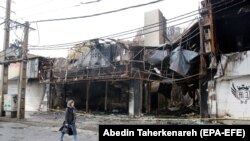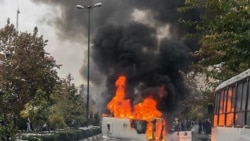Ali Saidi (Saeedi) , a hardliner cleric close to Iran's Supreme Leader, says Ali Khamenei has accepted full responsibility for the consequences of the plan to increase the price of gasoline in Iran.
This comes while Khamenei who has characterized the nationwide protests as a foreign intelligence operation has simply said that he supports the decision but never mentioned responsibility. Instead, he said clearly that he is no expert on fuel issues.
Protests that started November 15 after the price hike was announced, have entered their 6th day on Wednesday and have reportedly gained momentum regardless of officials’ claims about the situation being under control.
But Saidi, who is the chief of Khamenei's political and ideological office indicated that the protests came as a surprise. "The officials did not expect widespread protests," he said. He attributed the problem to a "poorly made decision" probably by the Rouhani administration.
Although he did not name anyone as the culprit, all the allusions he made to "threats" against the regime were about Rouhani's performance. He criticized Rouhani and his aides as "Westoxicated," and trying to create a situation to surrender to the West, making poor decisions, and creating a bi-polar situation in the society.
He also said that "some people want to topple the regime using the situation ahead of the parliamentary elections." However, He did not say who was behind the plan to change the regime.
Earlier, IRGC Intelligence Chief Hossein Taeb had also said that "infiltrators" were planning to enter the parliament by taking advantage of democracy." Iran is not particularly known for its "democratic" elections as candidates are scrutinized by hardline Guardian Council before they can run for the Majles.
In the meantime, the number of arrests and casualties have been on the rise according to international observers such as Amnesty International that put the number of confirmed deaths at a minimum of 106 on Tuesday. Radio Farda’s conservative estimate is around 140 killed.
At the same time, the pattern of demonstrations and the government's confrontation with them have been changing after five days. Protests take place mainly after dark and at least in one city, Mahshahr in southern Iran, there have been citizen reports about protesters using weapons against security forces who have been using tanks.
Mahshahr is probably the only city where the government has used tanks or armored vehicles to confront protesters, if eyewitness reports are true. Earlier reports from Shiraz said troops have shot protestors from helicopters during an operation to rescue a cleric. Other videos aired by foreign-based satellite TV show helicopters being used by security forces in Shiraz in southern Iran and Shahryar near Tehran.
ISNA has quoted the Rouhani administration's spokesman Ali Rabiei (Rabiee) that some protestors have used guns "that did not belong to the government." This is the first time an Iranian government official acknowledges that protestors have possibly responded to combat ammunition used by government forces.
Meanwhile, the fiercest protests and clashes in Tehran have been taking place in underprivileged parts of Shahryar, Malard, Shahr Quds, Chardangeh Qaleh Hassan Khan and Eslamshahr in the southwest of the city where most of the population are from the working class, and the middle class populated Tehran Pars in the northeast and Pirouzi in the central and southeast suburbs.
The Kayhan newspaper close to Khamenei's office quoted its photographer as having said that protests in southwestern parts of Tehran have been extremely rigorous. The daily typically uses derogatory terms to describe the demonstrators and often presents events in an oblique way to smear protestors' image.
Slogans in the underprivileged parts of Tehran often rhyme with swear words against Khamenei and other ruling clerics.
The trend reflects the well-known divide between the center and margins in Iranian society. The same pattern has been observed in Isfahan where although the situation in the province's capital city is still highly volatile, the heaviest clashes between government forces and protesters have been taking place overnight in six mainly industrial towns around the city.
While nearly all of Iran is affected by the protests, clashes have been fierce in the southern Khouzestan Province and western Kurdestan Province where casualty tolls are among the highest.






